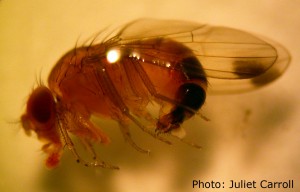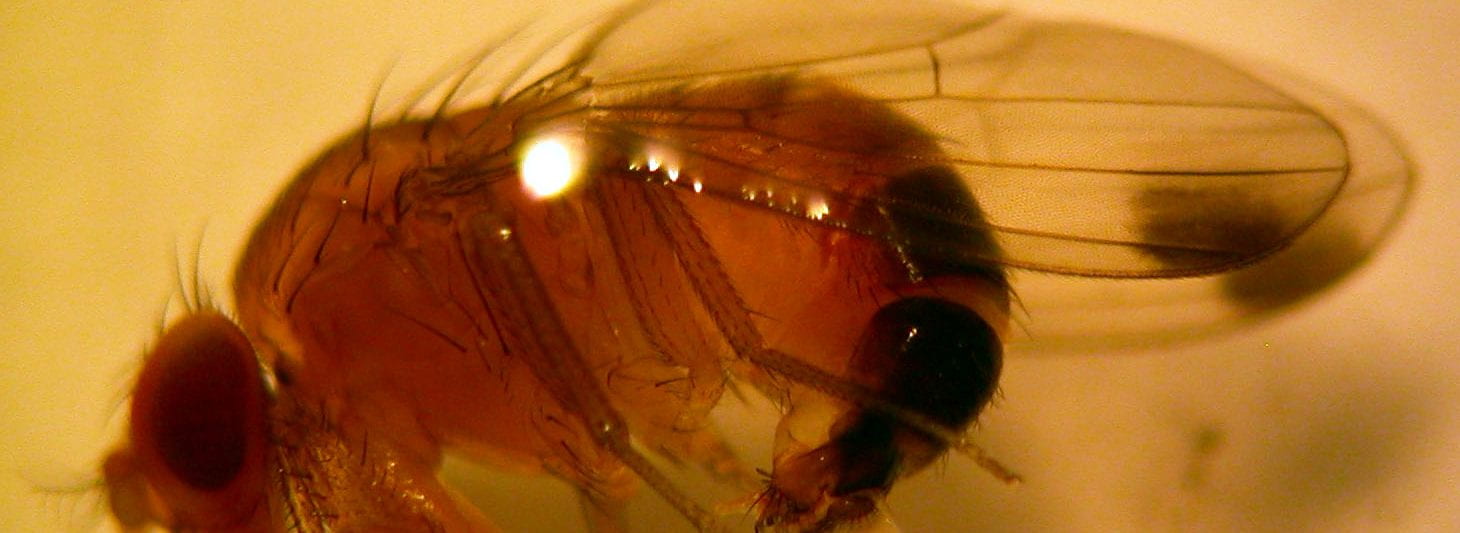Two SWD were caught in traps set in Albany County the week ending July 21, 2014, one male and one female. Traps were set in raspberries and are being monitored by Cara Henderson Fraver in Laura McDermott's program, Cornell Cooperative Extension, Eastern NY Horticulture Program. SWD trap catch remains relatively low across most NY sites this week. (GDD 1433; day length 14:47)
Month: July 2014
SWD monitoring video
The July 16, 2014 You Tube video from the Finger Lakes monitoring network shows male and female SWD alongside other fruit flies. Check out these videos to hone your skills at differentiating other fruit flies caught in traps from spotted wing Drosophila. Anna Wallingford, Postdoctoral Research Associate in Greg Loeb's program, Department of Entomology, Cornell University, Geneva, brings us these early each week. Check it out at https://www.youtube.com/channel/UCdiZ_cu0CFO8AYfN1EyctQg.
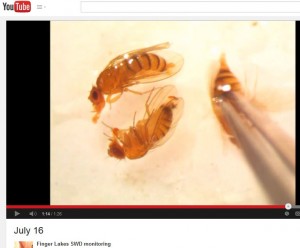
Monroe County – first find
Three female SWD were caught, one per trap, in a Monroe County summer raspberry planting in the week ending July 21, 2014 by Jacob Robinson, summer technician in Juliet Carroll's Fruit IPM Program. The summer raspberries are ripe and nearing the end of harvest. Because this planting is adjacent to a blueberry planting, it will be important to carefully plan an insecticide management program to protect the ripening blueberries. (Accumulated GDD 1296; day length 14:50)
Ontario County – first find
SWD adults have been caught at two locations in Ontario County this week ending July 17, 2014, five at one location and three at the other. All traps were the apple cider vinegar and fermenting dough cup trap and are monitored by Gabrielle Brind'Amour in Greg Loeb's program, Dept of Entomology, Cornell University, Geneva, NY. At one location, three females, one per trap, were caught in a summer raspberry planting; one of the traps was on the edge of the planting and the other two were within the crop. At that same location, one male and one female were caught in a trap placed in the nearby woods. At the second Ontario County location, one male and one female were caught in a trap on the edge of a blueberry planting, as well as a single male in a trap at the woods' edge facing the blueberry planting. (GDD 1235, day length 14:55)
First v. Sustained Trap Catch
Sustained trap catch is a milestone often used in IPM for timing management tactics against insect pests. Insect traps in the SWD monitoring network are checked once per week until adult SWD have been caught for two consecutive weeks at that location, indicating sustained trap catch.
On the blog, we post SWD first catch reports. Some of these reports may not prove to be first sustained trap catch because SWD adults are not caught the following week. This was the case this week for the traps in Suffolk, Onondaga, and Cayuga Counties. No SWD adults were caught at these locations this week, July 14 to 18, and in Suffolk County, no infested fruit was detected.
This indicates that SWD populations are still very low in NY. Cultural practices such as removing overripe berries from the planting, clean picking, dragging equipment across the ground to squash and break up dropped berries, etc., may provide some benefit, particularly in crops that are nearing the end of the harvest window, such as summer raspberries.
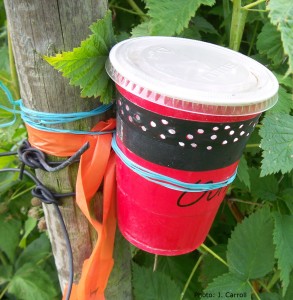
Schuyler County – first find
A single male and a single female were found on July 16, 2014 in yeast baited apple cider vinegar traps in Schuyler County by Gabrielle (Gabe) Brind'Amour in Greg Loeb’s program, Dept of Entomology, Cornell University, Geneva, NY. The male was in a trap set in the wooded edge of a blueberry planting and the female was in a trap on the edge of a summer raspberry planting. (GDD 1305, day length 14:54)
Because the population of SWD is still at very low levels in NY, take time to review available insecticides and plan a program for at-risk fruit that is beginning to ripen. Berry insecticide tables and tree fruit and grape insecticide tables are found on Cornell Fruit Resources.
Seneca County – first find
A single male SWD was caught on July 16, 2014 in a yeast baited apple cider vinegar trap set in a blueberry planting in Seneca County by Gabrielle (Gabe) Brind'Amour in Greg Loeb's program, Dept of Entomology, Cornell University, Geneva, NY. The population of SWD is still at very low levels in NY, providing an opportunity for growers to practice sanitation or clean-picking of fruit that is nearing the end of the harvest period. This early alert provides an opportunity to review available insecticides and plan a program for at-risk fruit that is beginning to ripen. (GDD 1270, day length 14:55)
All positive finds reported to date have been single individuals caught in single traps. There are two to four traps set at each monitoring location. Cornell Cooperative Extension has set 192 traps at 52 sites in New York. Traps are checked weekly.
Niagara County – first find
A single female was caught on July 15, 2014 at each of two locations in Niagara County. One location is a raspberry planting and the other is a blueberry planting. Two yeast baited solo cup traps were set at both locations by Liz Tee in Deborah Breth's Lake Ontario Fruit Program, Cornell Cooperative Extension. Fruit is ripe and ripening. An up-to-date distribution map for NY and the Eastern US can be found on the Cornell Fruit Resources SWD Distribution page, courtesy of the Southern Region IPM Center and the University of Georgia Center for Invasive Species and Ecosystems Health. (raspberry site GDD 1120; day length 15:00) (blueberry site GDD 1023; day length 15:01)
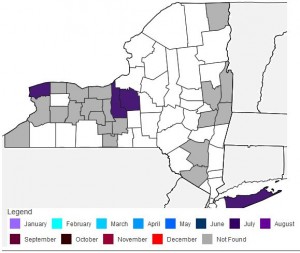
Cayuga County – first find
A single female SWD was caught in one of four yeast-baited apple cider vinegar traps checked on July 8, 2014 and set in a summer raspberry planting in Cayuga County by Juliet Carroll, NYS IPM Program. Fruit is ripe and nearing the end of harvest. Because at this time the SWD population is very low, if no other susceptible fruit is nearby and ripe, it may prove judicious to hold off on an insecticide management program. Consider creative approaches to sanitation in U-pick plantings such as providing a discount on purchased fruit when the customer brings in an extra bucket of damaged and over-ripe fruit to the counter. Keep track of fruit ripening in other berry crops and plan to protect these with insecticides in the coming weeks. (Accumulated GDD 1124; day length 15:05)

Onondaga County – first find
A single male SWD was caught in one of four yeast-baited apple cider vinegar traps checked on July 8, 2014 and set in a summer raspberry planting, variety Prelude, in Onondaga County by Juliet Carroll, NYS IPM Program. Fruit is ripe and being harvested. At this time the SWD population is very low and although cultural practices such as harvesting fruits frequently and removing rotten fruits from the field will help keep the SWD population down, if susceptible fruit is nearby and ripening, it may prove judicious to consider planning for and beginning an insecticide management program. SWD populations and damage can increase dramatically with favorable weather and susceptible ripe fruits. The weather in central NY has been cool at night with daytime temperatures in the upper 70's and low 80's. Insecticide applications are necessary when SWD populations are high. Insecticides labeled for use in commercial berry production are tabulated on the Cornell Fruit Resources' SWD website. (Accumulated GDD 1169; day length 15:09)
